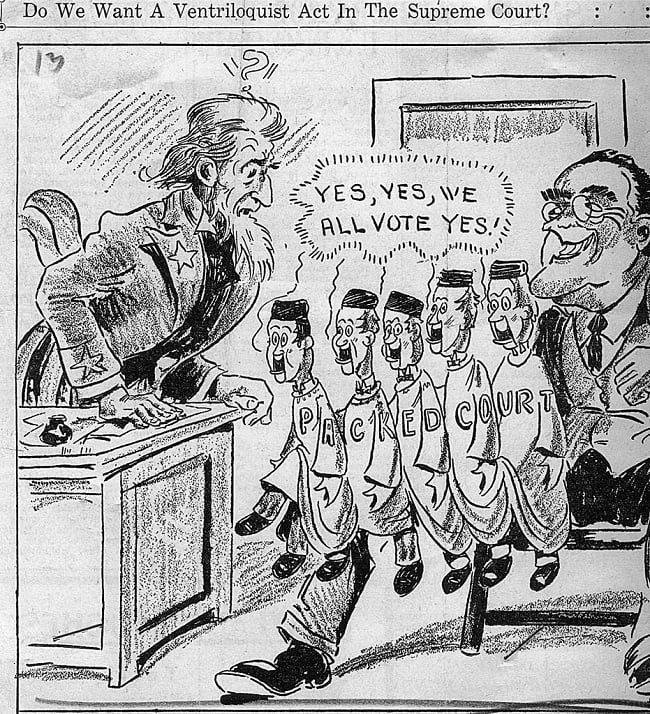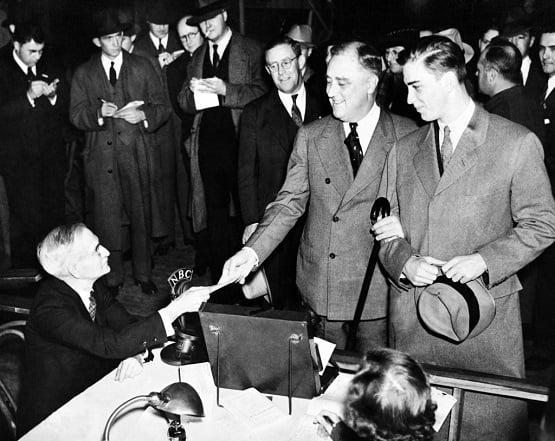On November 3, 1936, the 32nd president won a smashing reelection victory, defeating Republican challenger Alf Landon by more than 24 points in the popular vote, carrying 46 of 48 states; it was the biggest electoral landslide since 1820. In addition, FDR had long “coattails” to help down-ballot candidates; when the 75th Congress convened in January 1937, Democrats boasted a whopping 333 seats in the House and an even more whopping 76 seats in the Senate.
Thus it’s easy to see how such a victory could go to one’s head. As John T. Flynn, a contemporary—and fierce critic—of FDR, wrote of the reelected president:
He was in a gay and triumphant mood. A naturally vain man, the tremendous victory at the polls had swollen his ego enormously. Few men in public life have ever received such thunderous applause or been surrounded by so many flatterers.
It was in this flattered-up state of mind that Roosevelt set about settling some scores. Most notably, he knew that the U.S. Supreme Court had been an obstacle to his agenda; in his first term, the high court had invalidated several New Deal laws. In fact, FDR had used the Court as a foil during his reelection campaign, inveighing against “nine old men” blocking progress—and the tactic had worked.
So now, as he looked forward to pushing further to the left in his second term, Roosevelt and his aides hatched a plan for fixing the Supreme Court—starting with changing that long-standing number of justices, nine. As Flynn wrote, “He became more cocky and . . . decided that he was going to punish certain powerful enemies who had defied him. To begin with, he was going to bring the Supreme Court to its knees.” Thus the court-packing scheme was drafted inside the White House, neglecting any advance consultation with the Congress that would have to approve it.
Then on February 4, 1937, just two weeks after he had been inaugurated for a second term, FDR summoned the Democratic congressional leadership to the White House and unveiled his plan: For each judge over the age of 70—on the Supreme Court or for any other federal court—the president would be empowered to name an additional judge. In the case of the Supreme Court, that would mean that the membership would grow to a maximum of 15.
This was a sweeping proposal, completely overturning 150 years of precedent. Indeed, the reaction among Roosevelt’s fellow Democrats was instantly negative. Rep. Hatton Sumners of Texas, chairman of the House Judiciary Committee, declared immediately afterward, “This is where I cash in my chips.” That is, he was a firm “nay.”


As a sympathetic political biographer of Roosevelt, James MacGregor Burns wrote later, “The proposal at the outset split the American people neatly in half.” Sharp-penned newspaper editorialists immediately labeled the plan “court-packing,” an ugly image somewhat akin to ballot-box stuffing. In fact, one of those editorialists, William Allen White, wrote that for the first time in his presidency, opposition to Roosevelt was coming “not from the [top] hat section but from the grass roots.”
Intriguingly, biographer Burns noted that FDR’s court-packing plan came at a time when even many Democrats who had voted for the president were now growing fearful that the Roosevelt administration was becoming too radical. In those days of energetic labor-union organizing, noisy and sometimes violent sit-down strikes were becoming common on factory floors; as Burns put it, the resulting unrest was “disturbing to people who wanted law and order.” (Yes, it’s interesting to see how that powerful phrase, “law and order,” keeps popping up across the decades.)
So we can see: FDR’s court-packing plan was losing altitude from its very launch.
Moreover, the president made matters worse with ill-chosen arguments, bespeaking a dismissive attitude toward hallowed constitutional traditions. For instance, during a “fireside chat” on national radio, broadcast March 9, 1937, Roosevelt described the executive, legislative, and judicial branches of the federal government as a “three-horse team,” arguing that all three horses should be “pulling in unison’’—and lamenting that one of them, the judiciary, was not pulling in unison.
Surely James Madison, principal author of the Constitution, would have been horrified to hear this out-of-left-field profaning of the careful checks-and-balances mechanism that he had included in our guiding national document.
In fact, hearing such unconstitutional argle-bargle coming out of the Oval Office, even Democrats normally supportive of Roosevelt and the New Deal grew alarmed. For instance, Sen. Carter Glass of Virginia—coauthor of the landmark Glass-Steagall banking-reform legislation that the president had happily signed into law just four years earlier—said that the court-packing plan was “completely destitute of all moral understanding.” And Jim Farley, then simultaneously the postmaster general and chairman of the Democratic National Committee—such “dual-hatting” was possible in those days—recorded that he was “amazed at the amount of bitterness engendered by the Court issue.”
In the meantime, Sen. Henry Ashurst of Arizona, chairman of the Senate Judiciary Committee, used his convening authority to hold a Capitol Hill hearing on the court-packing proposal; Ashurst’s goal was to give a forum to the bill’s foes.
Indeed, Ashurst even went so far as to invite a non-member of the committee, the eloquent Sen. Burton K. Wheeler of Montana, to join the proceedings. Wheeler was normally a strong ally of FDR on domestic issues, and yet he was sufficiently alarmed at the prospect of “Caesarism”—that is, of a single man taking over too much power, as had Julius Caesar long before—that he rose in strenuous opposition to Roosevelt’s plan.
By July 1937, the court-packing plan was dead. It was a stunning defeat for the man who less than a year before had won such a resounding victory. Once again we are reminded of the wisdom of the ancient Greeks: Hubris begets nemesis.
However, FDR’s hubris wasn’t quite yet quelled. Angry over the failure of his court-packing plan, the president attempted to defeat, in Democratic primaries, some of his leading opponents—and once again, alert editorialists leaped to give this latest Rooseveltian stratagem a nasty name: They called it a “purge.” We might note that in those days, “purge” was a particularly fraught word, since over in the Soviet Union, Josef Stalin was overseeing a purge of his government, removing and executing thousands of fellow communists.
To be sure, it wasn’t fair to equate FDR’s attempt to defeat Democrats to Stalin’s decision to murder opponents—but nobody ever said politics had to be fair. The “p”-word, purge, stuck, and it further imprinted the fear that the Democrats were moving too far toward left-wing authoritarianism.
In other words, Roosevelt compounded a bad idea, the court-packing plan, with an even worse idea, an attempted intra-party purge. Interestingly, of the dozen candidates that FDR targeted, only one, Rep. John O’Connor of Manhattan, was actually defeated. All the rest—mostly in the South—survived, and they were now, unsurprisingly, not fans of FDR. Indeed, when one of the intended targets, Sen. Walter George of Georgia, heard the president joshingly described as “his own worst enemy,” George shot back, “Now while I am alive!”
For these and other reasons, the 1938 midterm elections were a disaster for the Democrats. The GOP gained a massive 81 seats in the House, as well as eight in the Senate. Indeed, beginning with the 76th Congress, Republicans and anti-Roosevelt Democrats joined together to create what became known as the “conservative coalition,” dominating Capitol Hill for the next quarter-century.
Roosevelt himself, of course, was reelected in 1940 and again in 1944. And yet the 1937 court-packing fiasco was a hinge in his presidency; he and the Democrats never again held sway as they had before.



